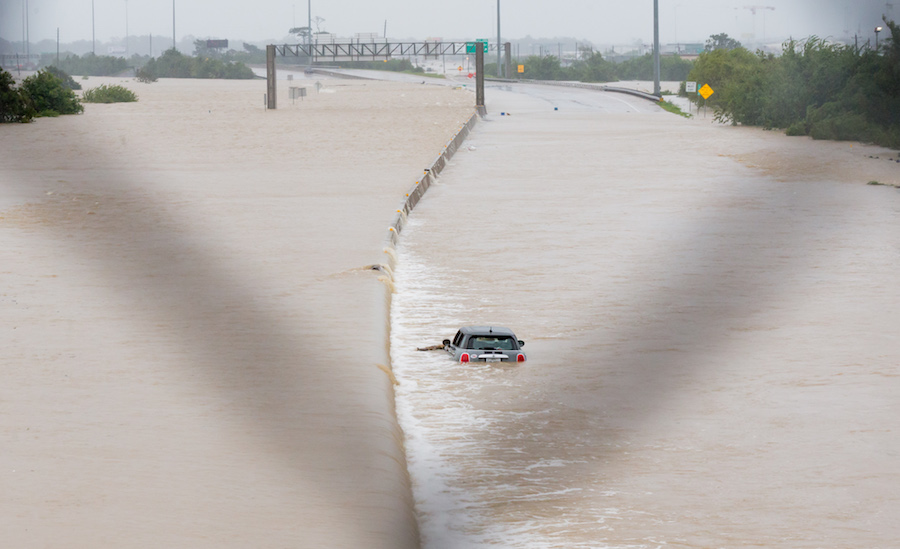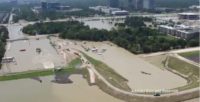Natural Disasters
Hurricane Harvey: Rain Stops in Texas as Lakes, Rivers Keep Rising

A Mini Cooper is stranded at the San Jacinto River, which is over the banks and making Interstate-10 heading east impassable Aug. 29, 2017. Photo: by Juan DeLeon/Icon Sportswire via AP Images.
Rainfall has let up in the Houston area, but with nowhere for the water to go, flooding is expected to persist. Flood stages have yet to be reached on rivers, and the Corps of Engineers and state authorities are trying to manage lakes and reservoirs to prevent further breaches.
The Brazos River levee at Columbia Lakes, south of Houston, breached on Aug. 29, causing the county to alert its residents via Twitter to “Get out now.” The levee has since been fortified with materials such as concrete sacks, Brazoria County Judge Matt Sebesta told PBS Newshour on Aug. 29.
North of Houston, the San Jacinto River Authority reported late on Aug. 29 that Lake Conroe’s water level is starting to slowly decline, with the current level at 203.7 ft above mean sea level (MSL), just 2.7 ft over the normal pool elevation of 201 ft MSL.
This situation is vastly different compared to record flooding in June 2016, Sebesta said. “When [the Brazos River] spilled its banks, it spilled into dry land, into a very normal Oyster Creek. [Now,] Oyster Creek is full, all low lying areas are full, roadside ditches are full, the soil is fully saturated from the rains that we’ve had over the last three days ranging from 10-15 in in some areas, over 30 in in others,” he said. “This river flooding event will be very different from last year.”
Fort Bend County Judge Robert Hebert released a video statement on Aug. 30, noting the National Weather Service has lowered the forecasted crest of the Brazos River to 56 ft from 57.5 ft, expected to occur sometime early Friday morning. “That’s the good news,” Hebert says. “56 ft is the 100 year flood event for Fort Bend County [which] is what our levees are designed to defend against, ... I have no indication that any levee is having difficulty keeping the river out.” Mandatory evacuation orders remain in place for many parts of Fort Bend County, southwest of Houston, as the flooding is still at historical highs. “It is still a major flood in Fort Bend County, and 56 ft far exceeds the current record, which was set during the Memorial Day floods of 2016,” Hebert says.
North of Houston, the San Jacinto River Authority (SJRA) reported late on Aug. 29 that Lake Conroe’s water level is starting to slowly decline, with the current level at 203.7 ft above mean sea level (MSL), just 2.7 ft over the normal pool elevation of 201 ft MSL. The controlled release rate from the Lake Conroe Dam has subsequently been reduced to 22,172 cubic feet per second (cfs) from its peak of 79,100 cfs.
Water levels in the river downstream of the dam are beginning to decrease as well, according to SJRA. inflow to the lake has been a major problem, according to SJRA, with peak inflow coming in at approximately 130,000 cfs, while the peak release rate from Lake Conroe was 79,100 cfs.
Corps Reservoirs Release More Water
The U.S. Army Corps of Engineers Galveston District (USACE) continued its controlled releases at the Addicks and Barker Dams on Aug. 30, increasing the discharge rates to approximately 7,000 cubic feet per second and 6,000 cfs, respectively, for a combined total discharge of 13,000 cfs.
The Harris County Flood Control District (HCFCD) noted on Aug. 29 that the additional releases have added to the out-of-banks flooding in neighborhoods along Buffalo Bayou, and that the higher-than-normal controlled releases will continue to minimize the risk of flooding both above and below the dams. The Corps is targeting eventual releases of 8,000 cfs for both dams.
According to HCFCD, the outlet gates at both Addicks and Barker were closed on Aug. 25, but with the reservoir pools reaching record levels, the controlled stormwater releases have had to be significantly larger than normal. HCFCD further reported that releases at varying levels will continue until the reservoirs are empty, which could take several months.
Both dams, originally built in the 1940s, normally remain dry in between rain events to preserve the total capacity to impound storm water and reduce flood levels in Buffalo Bayou, according to the USACE
However, in 2009, the Corps designated both structures as extremely high risk based on technical issues concerning the safety of the dams and the potential consequences to the city should the outlet structures fail. Structural concerns the Corps identified include the structures or gates in the dams that allow outflow into the bayou and the ends of the dams.
To amend that, in 2015, the USACE Galveston District awarded a $72 million contract to Granite Construction Co. for construction of new outlet structures at the Addicks and Barker Dams. Construction began in 2016 and is expected to take approximately five years.



